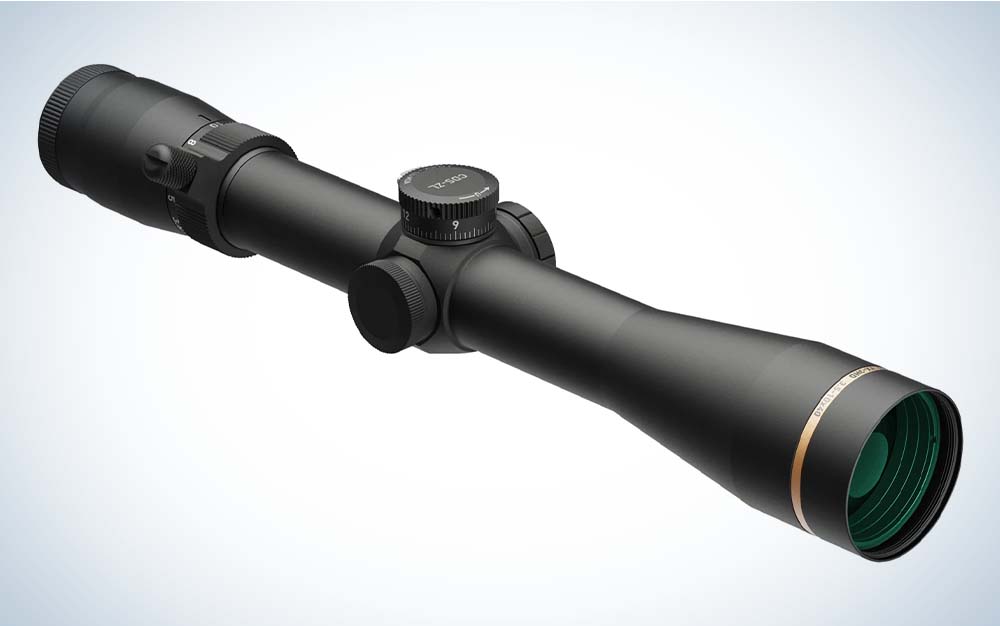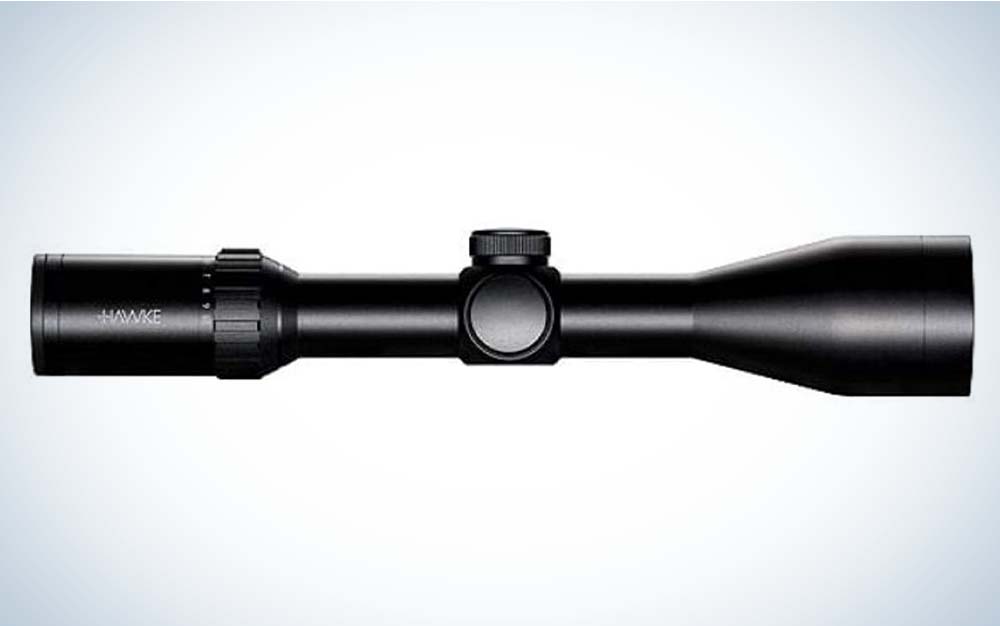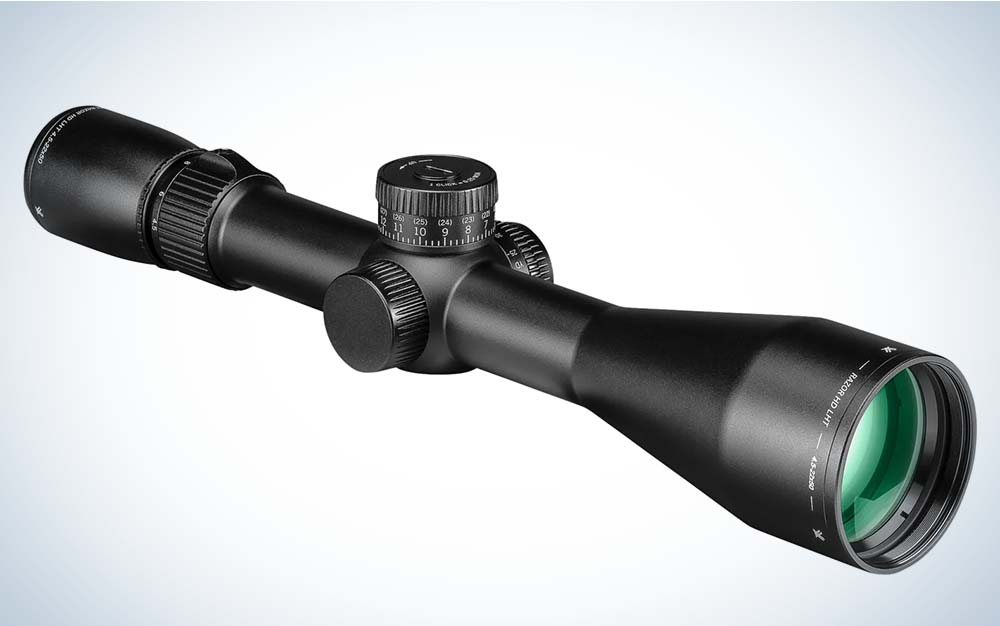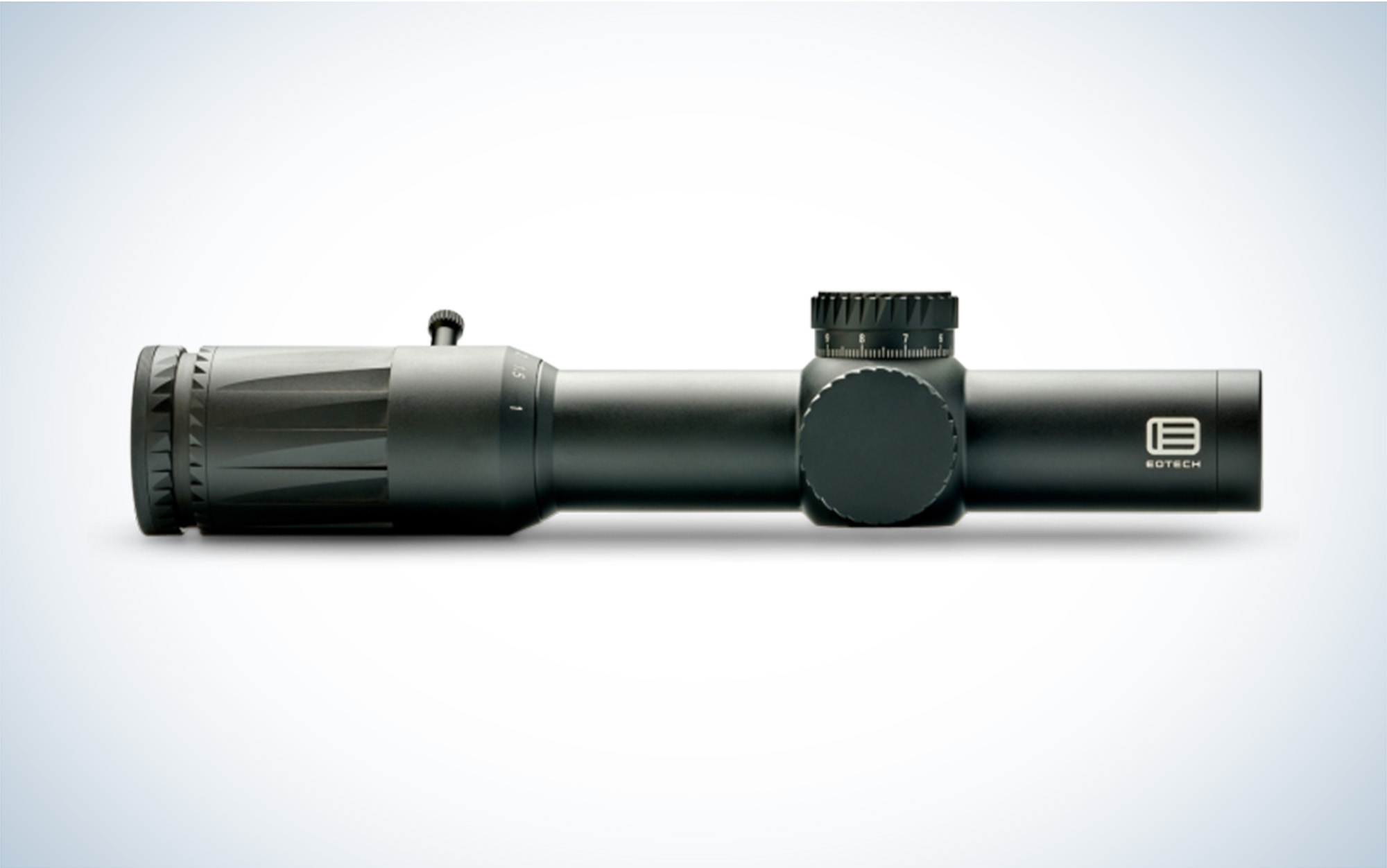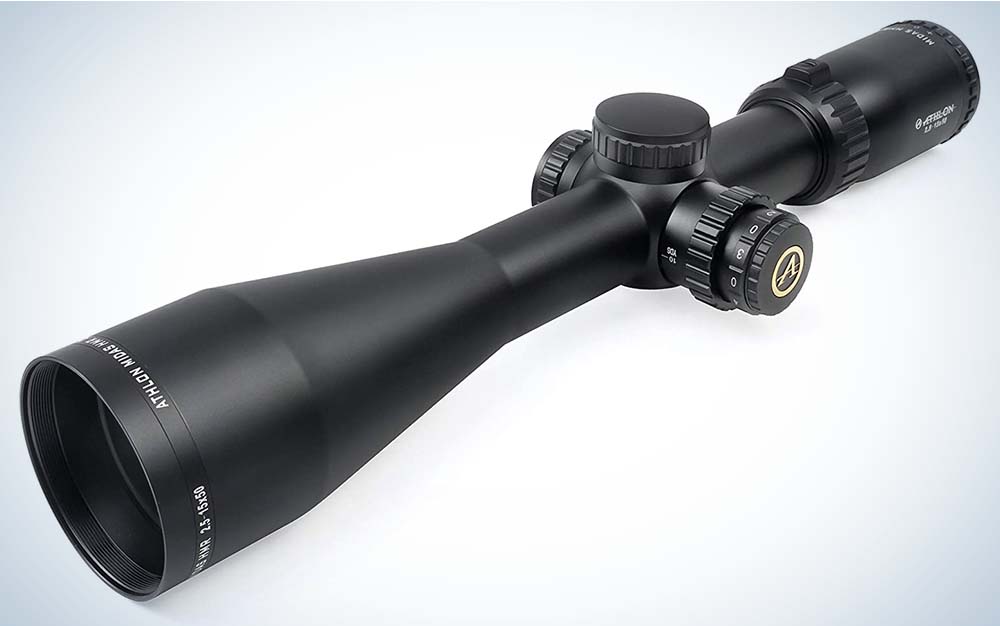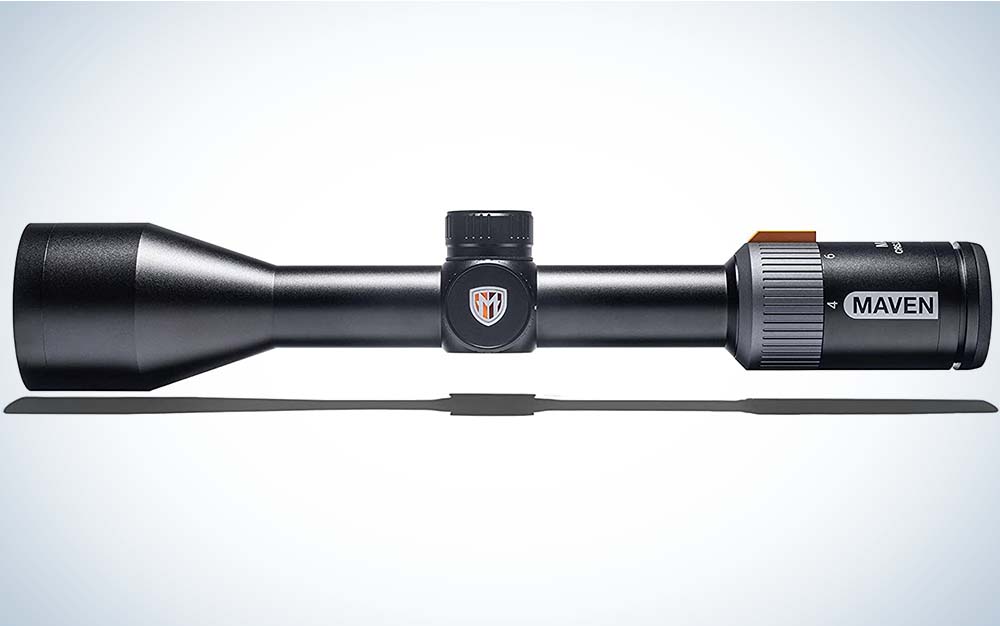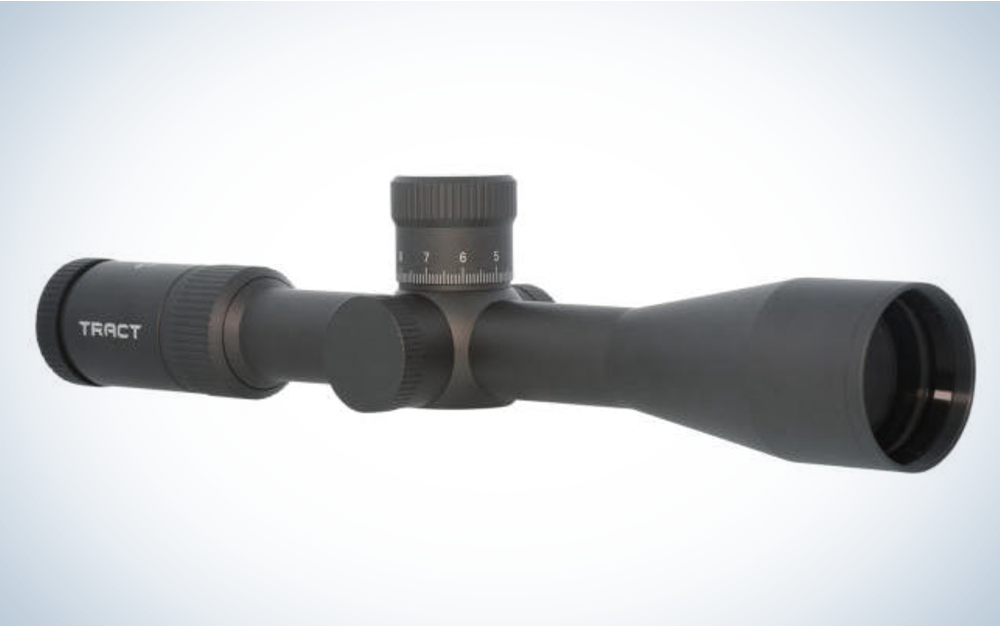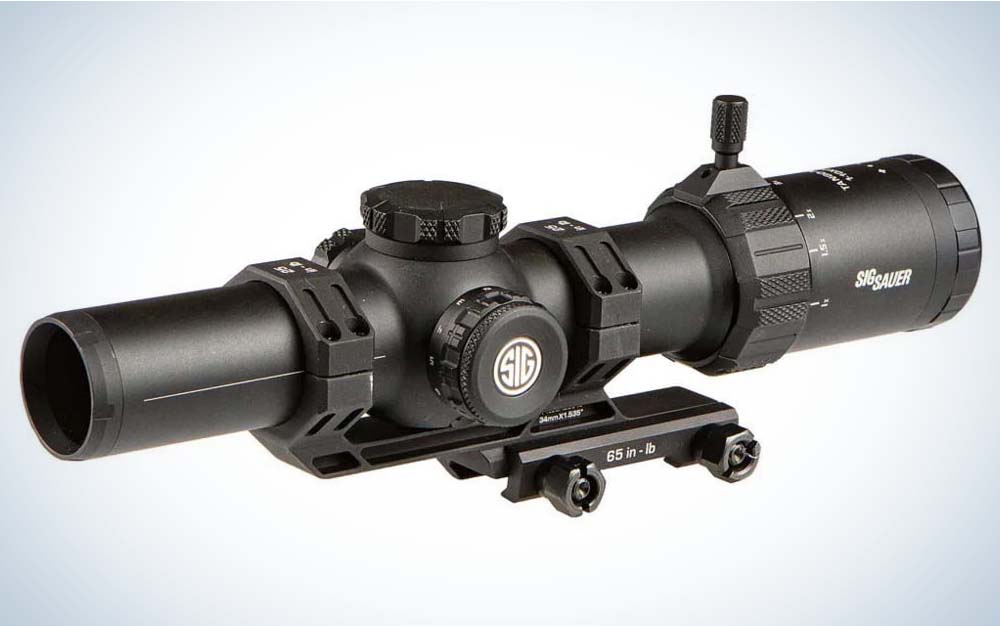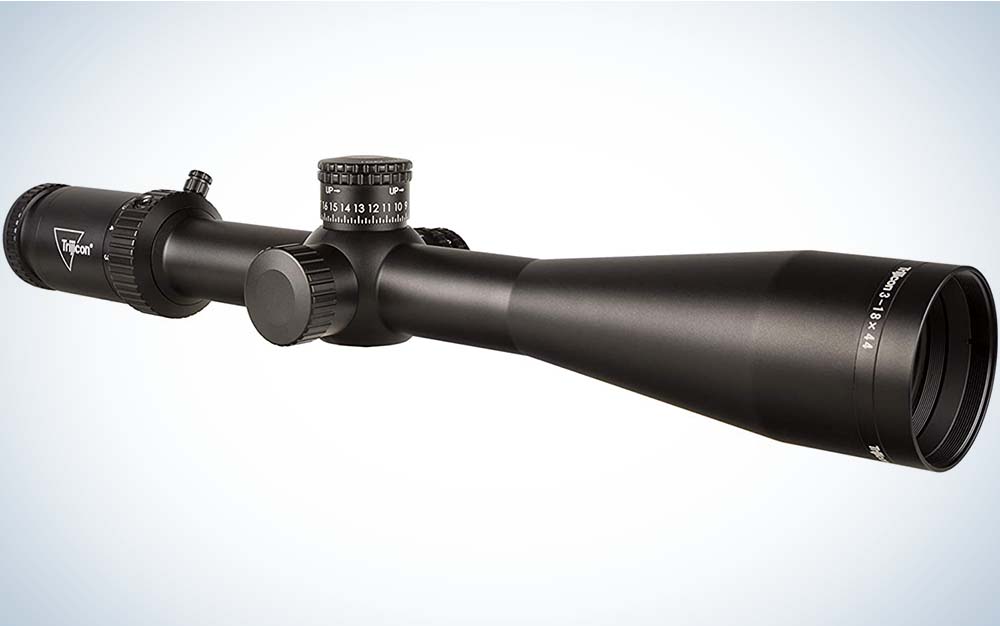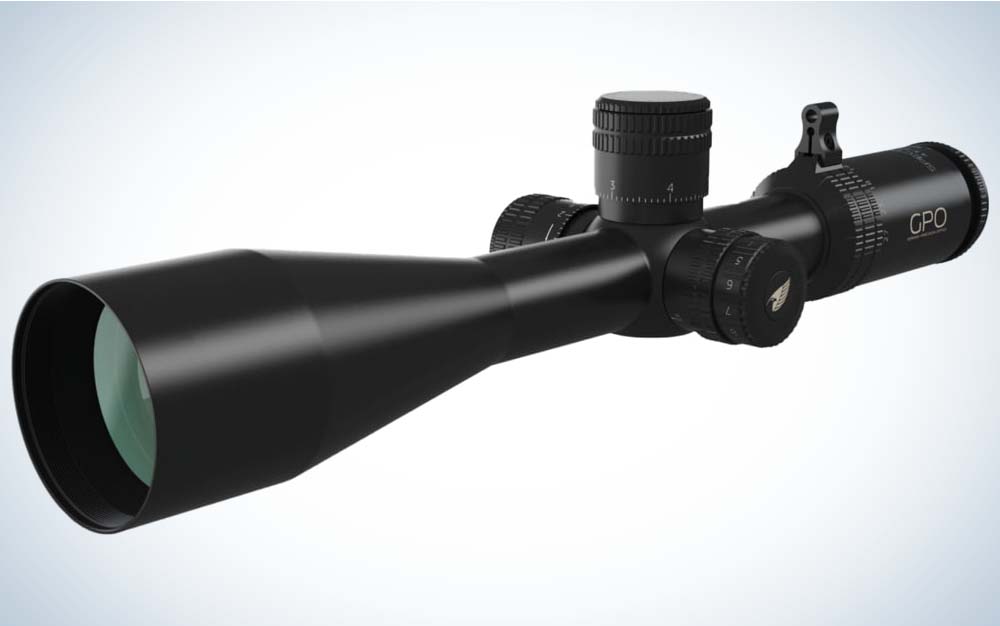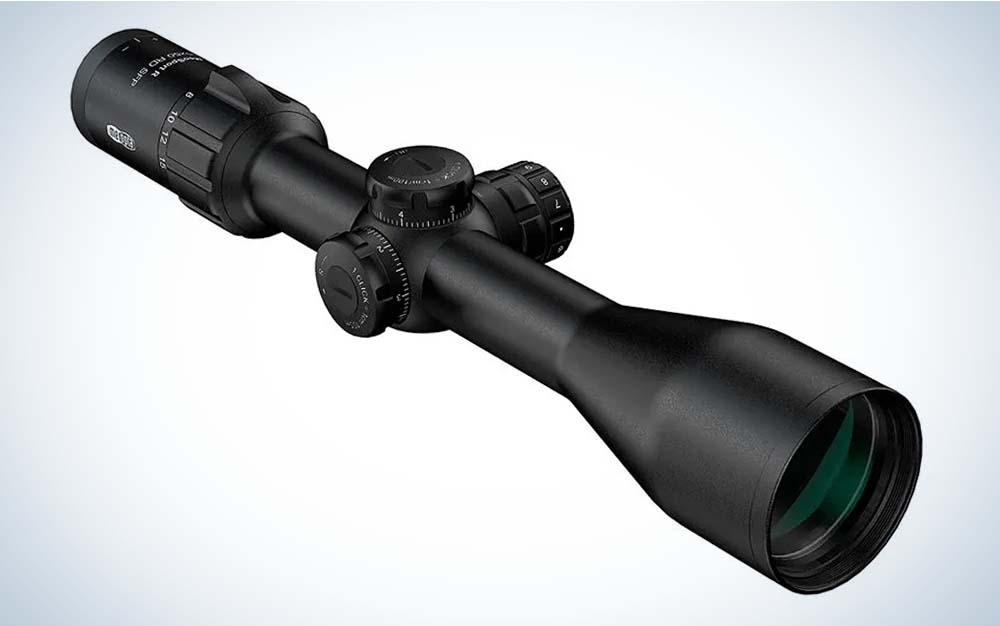We may earn revenue from the products available on this page and participate in affiliate programs. Learn More ›
Updated Jun 16, 2023 2:28 PM
Rifle scope designs follow trends in the rifles that they’ll be paired with. The 3-9×42 scope, one of the best all-around hunting optics mounted on generations of bolt-action rifles, held sway until rising sales of ARs convinced shooters they needed a short-range optic for home defense. Then long-range precision shooting, and the big chassis rifles that enable those super-long shots, became popular, and the optics industry cranked out big 5-25×56 scopes with supersized turrets and first-plane milling reticles to serve this new market of shooters.
This year’s trend in rifle scopes is a return to smaller configurations and wider versatility to pair with ARs and carbines that might be used for close-quarters shooting but require precise aiming points for mid-distance shots. And we’re seeing lightweight scopes intended to mate with the new generation of semi-custom ultra-light hunting rifles.
There are two patterns in the 2022 optics market: for that first species of gun, a flood of low-power variable optics (also known as LPVOs) that are configured in the 1-8 or 1-10x magnification range with 24mm objective lenses. These rigs are at home on ARs, but also on short-range carbines, shotguns, and even dangerous-game rifles. And for that second type or gun, we’re seeing a return to the versatile hunting scope, only this new crop borrows attributes from the precision-shooting world. These have magnification ranges from 3-to-12-power, or 4-to-16-power and are built on 1-inch or 30mm tubes behind modest-sized objective lenses.
These new versatile hunting scopes are meant to be paired with lightweight mountain rifles and offer tons of optical horsepower in small packages that are designed to place bullets with great precision—and confidence—when the trophy of a lifetime hovers in the thin air of a distant ridge. I tested a wide range of rifle scopes for their features, optical performance, and turret tracking. When the dust settled, I made my picks for the best rifle scopes for a wide range of uses and host rifles.
How We Tested the Best Rifle Scopes
I started by collecting test samples of scopes that are readily available on the market. Some are new for the year, others have been in circulation for several years; note that I did not test every single scope on the market, but rather a representative sample of what’s available. I then measured the optical attributes of each entry, giving each an optical resolution score and testing their low-light performance by viewing a black-and-white resolution target as evening came on my test site in eastern Montana. Unlike the low-light testing that I subject entries in Outdoor Life’s rigorous annual test of new optics, I subjected rifle scopes in this roundup to only one night of testing.
Finally, I strapped all these scopes to slave rifles and shot them at a battery of targets of various sizes and distances. I use Bergara’s B-14 R, one of the best rimfire rifles, for this portion of the test, because I shoot about 60 rounds per scope, and center-fire rifles tend to beat up the test team. Thanks to my friends at Federal and Remington for supplying match .22 ammo.
The shooting portion tests the ability of each scope’s turrets and reticle to track up and down and then return to zero. I also test the precision of turret and reticle references. The one thing I don’t do is submerge, freeze, and then thaw scopes. I’ve learned through many years of optics testing that only a vanishingly small percentage of scopes will fail this kind of torture testing, and I’d rather spend my time with more meaningful evaluations.
Best Rifle Scopes: Reviews and Recommendations
Best Precision Hunting Scope: Zeiss LRP S5 3-18×50
Key Features
- Magnification: 3.6 to 18 power
- Field of view at 100 yards: 30 to 6 feet
- Adjustments: .1 MRAD or .25 MOA
- Weight: 32.8 ounces
- 34mm tube
- Massive amount of internal adjustment
- Extremely tactile turrets
- Precise first-plane reticle
Pros
- Extremely bright and high-contrast glass and coatings
- First-plane turret available in MOA or MRAD values
- Precise, positive turrets
- Internal adjustment range enables shots from 100 to 1,500 yards
Pros
- At over $3,000, this is a pricey scope
- The illumination module on my sample didn’t work
A serious precision hunting scope from one of the members of European optical royalty, Zeiss’s LRP S5 combines the best attributes of long-range precision shooting with a smaller, more versatile configuration. At 2 pounds, this is still a whale of a scope, but its relatively short (13-inch) length and 50mm profile allow for versatile mounting options.
The guts of the scope—my test sample had the ZF-MOAi Reticle 17 tuned to MOA references—is smart and useful. From 3.6 to about 10-power the first plane reticle features a fast, intuitive German 1 bold duplex, but from 10- to 18-power, the precision references come into view, offering 40 MOA of holdover and hold-off windage references with 1 MOA hashes. The scope is also offered in an MRAD version that has a modified Christmas tree design with holds represented in 0.2, 0.5, and 1.0 MRAD increments. Both versions are designed to enable shooters to dial holds from 100 to 1500 yards without using the reticle’s holdover references.
This is a big, serious, purpose-built rifle scope that was years in the making. Zeiss has a winner on its hand, though unfortunately, there’s a small subset of hunters who will use the LRP S5.
Most Versatile Hunting Scope: Leupold VX-3HD 3.5-10×40
Key Features
- Magnification: 3.5 to 10 power
- Field of view at 100 yards: 29 to 11 feet
- Adjustments: .25 MOA
- Weight: 13.1 ounces
- 30mm tube
- Locking exposed elevation turret
- Elevation turret compatible with custom CDS dials
- Simple duplex second-plane reticle
Pros
- 40mm objective allows for low mounting
- Custom Dial System (CDL) enables shooters to match elevation turret to their specific load
- Removable throw lever makes magnification changes easy and fast
Cons
- Second-plane duplex reticle could use some elevation references
- Fixed parallax focus at 100 yards makes near and far targets slightly fuzzy
The best rifle scope for hunting will vary depending on your purpose, but if you need to make a snap 50 yards shot one day and a 300 yard precision shot the next, the Leupold VX-3HD is a great option. With few moving parts to break or tweak, this simple, durable workhorse will deliver years of reliable, if unflashy, service to shooters. It’s remarkable for what it isn’t. The VX-3HD is not a precision scope. It doesn’t have lots of dials and illumination modulation. It isn’t going to help you ring steel at 2,000 yards. But what it does have is restrained simplicity. If you add a custom turret, you simply range your target and dial to the distance, then hold right on and shoot. It doesn’t have any batteries or connect via Bluetooth to a mobile app.
Instead, it’s a straight-ahead rifle scope, with a duplex reticle in the second plane. Weighing only 13 ounces, this is the perfect companion for an under-6-pound mountain rifle.
The VX-3HD is fully functional right out of the box, but to get the most out of its somewhat pedestrian turret, spend the time to blueprint your load, and then order a custom dial. With the right CDS turret, this is a fast, close-enough hunting scope that is both affordable and durable enough to last longer than the rifle you mount it on.
Read Next: Best Thermal Scopes
Best Budget Scope: Hawke Vantage 30 WA IR 2.5-10×50
Key Features
- Magnification: 2.5 to 10 power
- Field of view at 100 yards: 50.4 to 12.6 feet
- Adjustments: .25 MOA
- Weight: 21.2 ounces
- Second focal plane
- Red and green center-dot illumination
- Capped turrets tuned to MOA click values
- Simple duplex reticle in second focal plane
Pros
- Center-dot illumination displays aiming point in variety of light conditions
- At 21 ounces, light enough for mountain rifles
- Close focus is configured for .22 matches
Cons
- Elevation turret indexing hard to see
- Lack of reticle references frustrates holdover and hold-off aiming
Compare the Hawke with the Meopta (at over $100 more). Both feature similar duplex reticles and both are configured for all-around hunting and mid-range shooting. In terms of brightness and image quality, the Meopta is the better optic, but the Hawke has some sweet shooting attributes. They include the 10-yards to infinity parallax focus, a feature that makes this a good rimfire scope. I also like the relatively light weight of this unit, and the silky positivity of its controls.
The Hawke’s glass is also better than I expected for such a modest price. In all, it’s a scope with lots of versatility that performs with peers costing twice as much. The Hawke Vantage is also one of the best air rifle scopes for your PCP small game or big bore rifle.
Read Next: Best Rimfire Scopes
Best Crossover Scope: Vortex Razor HD LHT 4.5-22×50
Key Features
- Magnification: 4.5 to 22 power
- Field of view at 100 yards: 23.5 to 4.7 feet
- Adjustments: .25 MOA
- Weight: 21.7 ounces
- First-plane precision reticle
- Locking exposed elevation turret, capped windage turret
- Push-button illumination control
- 25-yard-to-infinity parallax
Pros
- Ability to focus as close as 25 yards makes this a decent rimfire scope
- XLR-2 MOA-based reticle is useful without being cluttered
- Push-button illumination is smart and both bright and subdued
Cons
- The elevation turret turns a little too easily
- Like to see a MRAD version of this reticle
The Razor HD line has Vortex’s best glass and controls, but the LHT (it stands for Light Hunter Tactical) brings a versatile first-plane reticle to the game. The MOA-based reticle has abundant elevation and windage references for shooters who like to hold for long shots. For those who prefer to dial turrets for their aiming solution, the locking elevation dial is nicely indexed.
Vortex has done a nice job of offering a hunting scope that will feel like a precision tactical scope for long-distance target shooters, and like a precision target scope for long-range hunters. It’s the ultimate crossover scope, with a first-plane reticle tuned to MOA references, a low-profile locking elevation turret that’s easy to dial, along with a capped windage turret, and a rock-solid turret zero stop. By combining features from hunting and long-range precision shooting, the Razor HD LHT is precise without being ponderously heavy and big.
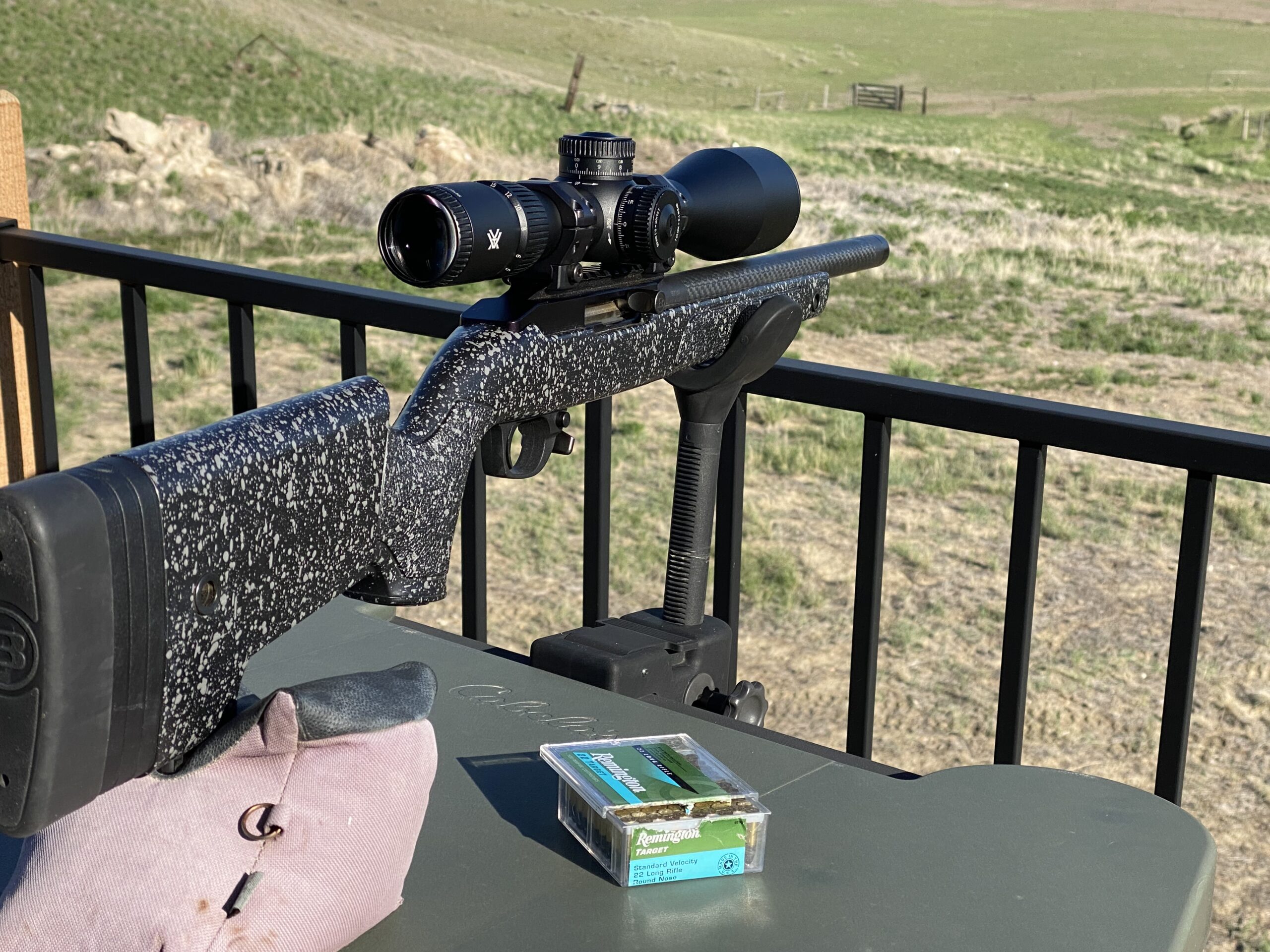
At 21.7 ounces, the 30mm scope is not a featherweight, but would be right at home on a lightweight hunting rifle. And it keeps its trim figure by combining the illumination module inside the parallax dial. Inside, the Razor HD LHT features 75 MOA of total elevation adjustment and 45 MOA of windage adjustment. The glass is bright, coatings make the image pop, and it has great durability along with Vortex’s legendary lifetime transferrable warranty.
Read our full Razor HD LHT review to learn more.
Best LPVO: EOTech Vudu 1-10×28
Key Features
- Magnification: 1 to 10 power
- Field of view at 100 yards: 116.6 to 11.7 feet
- Adjustments: .25 MOA or .1 MRAD
- Weight: 21.3 ounces
- 34mm main tube
- Pull-to-turn elevation turret
- First-plane LE-5 reticle
- Magnification dial throw lever
Pros
- Battle-hardened durability
- 34mm tube contains 29 MRAD of elevation travel and 23 MRAD windage travel
- Pull-to-turn elevation turret is precise and tight
- Scope is available in MOA reticle/turret configuration
- Push-button illumination is smart and precise
Cons
- At 21.3 ounces, this is a tank of a scope
- Configuration limits utility to ARs, shotguns, and carbines
EOTech’s Vudu has long been on the leading edge of innovation in the low-power variable optic category, and the 1-10×28 version continues the legacy. The first-plane LE-5 reticle, based on MRAD values, functions as a close-quarters red-dot scope from 1x to about 6x, but from 6-10-power its precision references come into full view.
This year’s best argument for a versatile rifle scope, this hybrid optic from EOTech serves marvelously as a close-quarters scope for a variety of platforms. It’s a great personal defense optic for ARs, can serve as a ranch-rifle scope for a straight-wall carbine, and would be a great partner on a dangerous-game rifle in search of African buffalo or elephants.
But the EOTech’s true capabilities shine at magnifications above 6-power, when the first-plane reticle enlarges to reveal its precision references. My test model was a LE-5 tuned to MRAD references, and at powers above 6x, it reveals a Christmas-tree design with 12 mils of drop and 12 mils of windage hold, with 6 mils on either side of the crosshair center aiming point.
The push-button illumination module is precise and easy to turn on, off, and vary the intensity of the center aiming point. With a 34mm tube, this is a large scope for close-quarters work, but because it has so much capability in its 1-10-power magnification range, it’s at home on a wide variety of rifle platforms.
Best Budget Precision Rimfire Rifle Scope: Athlon Midas HMR 2.5-15×50
Key Features
- Magnification: 2.5 to 15 power
- Field of view at 100 yards: 22.7 to 3.6 feet
- Adjustments: .25 MOA
- Weight: 26 ounces
- Second-plane hash reticle
- 6-step illumination intensity
- 30mm tube
- 10 yards to infinity parallax
Pros
- Close focus makes this a good rimfire precision scope
- MOA-based reticle and turrets appeal to hunters
- 50mm objective is suited for low-light hunting
Cons
- Red illumination could use less intensity
- Hash-style reticle could use a few more windage references
Product Description
Once they graduate from the simple duplex reticle, most hunters want reticle references that give them holdover (elevation) marks and holdoff (windage) marks. But they also want a scope that won’t bog them down. Athlon’s Midas HMR is a good choice. It has decent second-plane reticle references inside a versatile package at a fair mid-range price. It has liberal mounting dimensions along its 30mm tube, and it has pretty good glass for the price.
Where the Athlon shines is delivering performance for an accessible price. In the case of the Midas HMR, performance items include resettable turrets with surprisingly tactile click values, parallax that focuses as close as 10 yards—making this a good rimfire scope—and a fairly useful reticle. While I’m on the reticle: it could use some additional reference points, and the alternating hash configuration is a little confusing. But for a scope that can serve every shooting pursuit from rimfire to big-game, there’s a lot to like about this Athlon.
Best Compact Rifle Scope: Maven CRS.2 4-16×44
Key Features
- Magnification: 6 to 16 power
- Field of view at 100 yards: 25.6 to 6.4 feet
- Adjustments: .25 MOA
- Weight: 16.93 oz
- Second-plane duplex reticle with 3 elevation references
- 1-inch tube
Pros
- Extremely lightweight
- Simple controls boost durability score
- Bright glass
- 1-inch tube
Cons
- Lack of reticle references may frustrate precision shooters
- Capped turrets could use more tactile click values
While many brands are moving to specialist rifle scopes, specifically configured for long-distance steel targets or for AR-mounted close-quarters target engagement, Maven has introduced a useful throwback: a versatile hunting scope. The magnification range and 44mm objective make the CRS.2 a great fit for Western hunters or Midwestern whitetail hunters who might have to make longish shots.
If second-plane duplex SHR (Simplified Holdover Reticle) isn’t designed for long-distance precision work, its design enables both quick shooting and mid-range holdover shooting, by utilizing its three elevation references. With some work, a shooter can match those holdover hashes to the specific ballistic drop of their load, and then determine how much holdover to allow at specific magnifications.
While the turrets are nothing fancy, the glass and tight controls of the Maven are worth considering, along with the very accessible price from this direct-to-consumer brand.
Best Long-Range Hunting Scope: Tract TORIC UltraHD 2.5-15×44
Key Features
- Magnification: 2.5 to 15 power
- Field of view at 100 yards: 41.7 to 7.1
- Adjustments: .1 MRAD
- Weight: 28.3
- Available in MOA or MRAD first-plane reticle
- 30mm tube
- Oversized locking elevation turret
Pros
- Turrets have very positive, tactile clicks
- Handsome graphite finish
- 10-to-infinity parallax focus
- Excellent SCHOTT high-definition glass
Cons
- Oversized elevation turret can get hung in scabbards
- Finish shows mars and scratches
This pleasing scope is squarely aimed at hunters who expect to take long shots. The scope’s configuration enables low mounting on rifles and the magnification range is perfect for just about any Western hunting scenario. But the aiming system—from the oversized exposed elevation turret to the first-plane reticle that’s available in either MRAD or MOA configurations—can be used with equal success by hunters who want to hold for an aiming solution or who prefer to dial. The windage turret is smartly capped; the elevation turret has bold indexing and Tract’s Multi Rotation Zero Stop.
My test sample came with the MOA-based Hunting Reticle—it’s also available in the FFP MRAD version—that features .25MOA turret click values and 1 MOA hash marks with larger 5 MOA marks for quick holdover and wiing holdoff. Though the scope is built on a 30mm tube, it features a whopping 100 MOA (30 MRAD) of total elevation adjustment. For close-in work, the scopes have a parallax focus that zooms in to just 10 yards, making this a great choice for those entering the fast-growing .22 precision target competition.
SIG TANGO-MSR 1-10×28
Key Features
- Magnification: 1 to 10 power
- 34mm tube
- Capped turrets tuned to ½ MOA click values
Why It Made the Cut
The name of Sig’s TANGO-MSR scope gets at its purpose: as a short- and medium-range optic optimized for AR platforms. But the scope’s surprisingly precise reticle has tons of versatility, and makes the TANGO a serviceable shotgun or dangerous-game rifle scope.
Pros
- 11 illumination intensity levels
- Inverted horseshoe second-plane reticle has useful references
- Ships with 34mm cantilever mount
- Magnification throw lever enables fast power changing
Cons
- 34mm tube adds to weight and bulk
Product Description
At its lowest magnifications, this billy club of a scope is one of the best true 1x scopes on the market. With the center aiming point illuminated and the eye directed by bold duplex arrows, the TANGO performs as a non-magnified red dot, enabling very fast target acquisition in close quarters. From about 5x to 10x, the second-plane reticle’s precision aiming points come into play.
With an inverted horseshoe center aiming point, the reticle has 6 holdover references and windage dots for both 5 and 10mph crossing winds, making it a surprisingly useful precision scope. The capped turrets deliver ½ MOA click values, and the scope has a whopping 100 MOA of total internal adjustment, enabling shooters to dial for far-out shots if they don’t want to hold over.
The TANGO-MSR ships with a 34mm cantilever mount, which should make mating to the rail of almost any AR a cinch. The scope also has a “racing stripe” on the left barrel to help reduce canting introduced by a cockeyed mounting job.
Trijicon Tenmile HX 3-18×44
Key Features
- Weight: 24.4 oz
- 30mm tube
- Green and red illumination
- First-plane MOA reticle
Why It Made the Cut
Another in a growing class of cross-over scopes, the Tenmile HX has the bones of a hunting scope with the guts of a precision target scope. The first-plane “Precision Tree” reticle is both fast and precise for shooters who prefer to hold for aiming solutions or who would rather dial turrets.
Pros
- Exposed elevation turret and capped windage turret turn with precision
- 44mm objective lens makes for low-mounting options
- 10-step illumination intensity shows up in any light condition
- 15-yard-to-infinity parallax focus makes this a good rimfire scope
Cons
- At over $2,000, it’s a spendy optic
- Reticle visibility reduced after about 15-power
Product Description
Trijicon has done a marvelous job delivering a scope for hunters who might have to reach out to deliver their bullets but who don’t want the bulk and weight of a precision target scope. The Tenmile HX is slim and mates nicely with a walk-about rifle but has marvelously precise aiming attributes. They start with the exposed elevation turret, tuned to .25 MOA click values, and extend to the first-plane “Precision Tree” reticle that has a series of hashes for elevation holds and dots for windage references. The scope has 60 MOA of total internal adjustment and what Trijicon calls its “exposed zero stop.” The elevation turret is compatible with customized dials from Kenton Industries.
The illumination module delivers good reticle visibility in a wide variety of light conditions, and I like the off settings between intensity steps. The glass and coatings are excellent, the magnification range is just about right for a wide variety of hunting scenarios, and the 30mm tube has generous mounting dimensions.
GPO Spectra 6x 4.5-27x50i
Key Features
- 34mm tube
- First-plane milling reticle
- Exposed locking turrets
Why It Made the Cut
A high-magnification extension of GPO’s Spectra 6x line, this 4.5-27x version is configured for a hunter who wants to dial for far-distant aiming solutions. It has tactile controls, a hash-style milling reticle in the first focal plane, and infinitely adjustable illumination.
Pros
- Rheostat-based illumination
- Huge magnification range
- 34mm tube enables lots of internal reticle adjustment
Cons
- Reticle isn’t readily visible until about 8x
- Oversized turrets snag easily
Product Description
GPO has gone all in to service the rising number of Western hunters seeking a precision reticle inside a hunting scope. In fact, the Spectra 6x has so many attributes of a precision target scope—34mm tube, oversized uncapped tactical turrets, and a whopping magnification range—that it might be a bit much for many walk-about hunters. But for those who want to dial their scopes to deliver bullets to distant targets, there’s a lot to like.
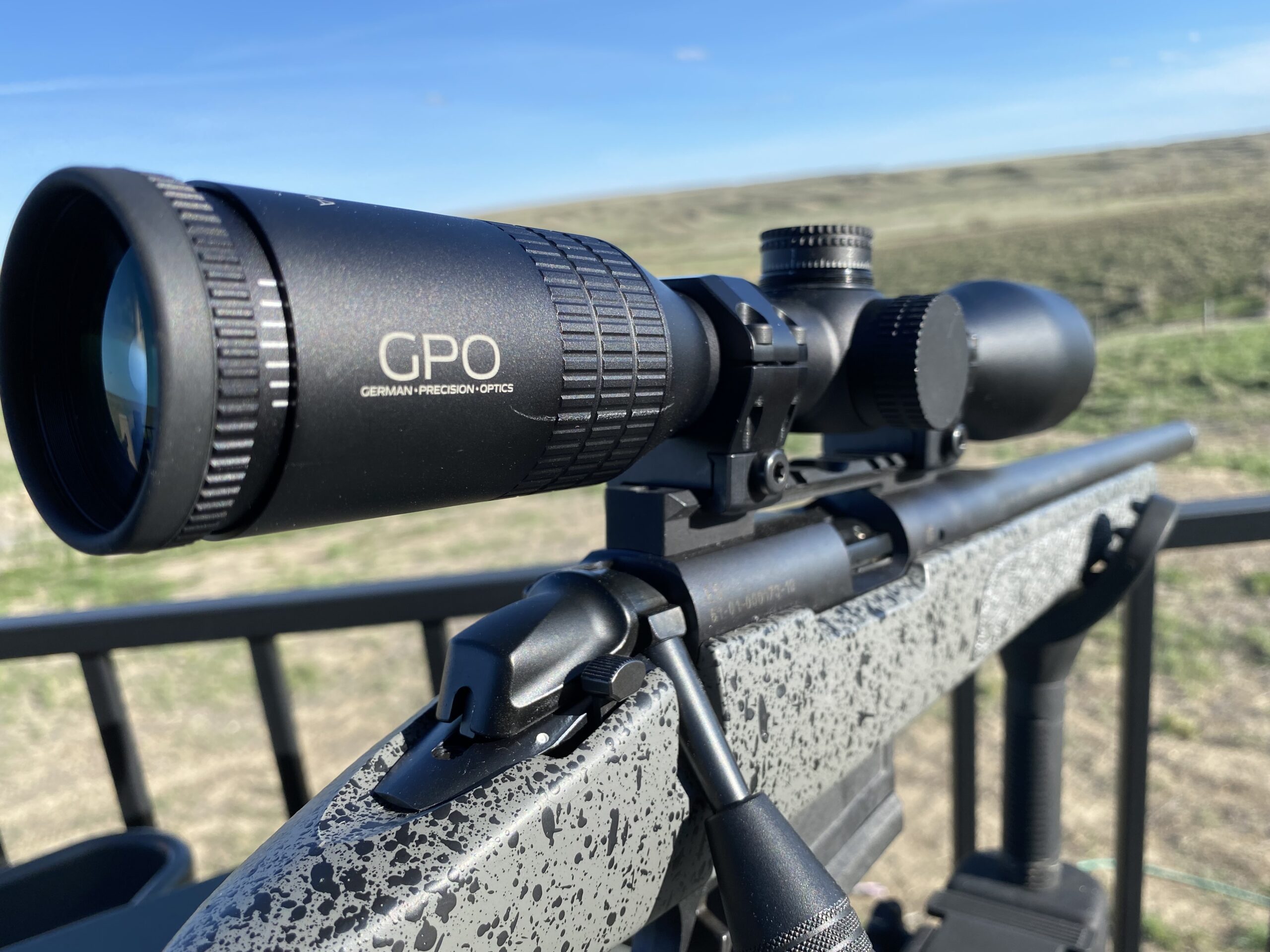
The pull-to-dial turrets turn with satisfying precision and tactile responsiveness. The parallax, which ranges from 25 yards to infinity, makes images crisp at any distance, and the infinitely adjustable illumination is easy to customize to any light condition. The turrets are tuned to 0.1 MRAD click values, and the indexing and revolution indicator are both first-rate and should minimize tendencies for shooters to get “lost” in the turrets.
The glass is good, and the reticle is simple but useful in the middle of the magnification range, from about 8 to about 20X.
Meopta MeoSport R 3-15×50 RD SFP
Key Features
- German 4 duplex reticle in second plane
- 30mm tube diameter
- Center-dot illumination
Why It Made the Cut
A wonderfully versatile entry-level scope, the MeoSport R is as home on a whitetail-deer rifle as it is on an AR-15 intended for coyotes or mid-distance target shooting. In addition to tasty center-dot illumination, focus from 10 yards to infinity, and good glass, the MeoSport R ships with 30mm rings.
Pros
- Wide versatility, from bolt-action hunting rifles to ARs
- Ships with 30mm rings
- Pull-to-turn re-zeroable turrets are fast and precise
- Close-focus makes this a great .22 scope
Cons
- Illumination creates lots of stray light
- Exposed turrets can allow moisture and debris into scope
Product Description
What a value for under $500. The MeoSport R delivers an excellent image and decent durability in a package that serves most deer hunters east of Kansas. The illumination is precise and handy in a wide variety of light conditions, and the 10-to-infinity focus makes this an excellent choice for .22 precision competitions.
I’d like to see a few more references, for both holdover and hold-off, but the simple duplex reticle in the second plane will get your shots on target whether mounted to a bolt-action deer rifle, a fast-shooting AR, or even a shotgun or carbine.
Equally attractive is the price. At well under $500, this is an affordable scope that should deliver years of service as it’s traded from one rifle to another.
Things To Consider Before Buying a Rifle Scope
The first is cost. Quality rifle scopes can cost more than even the best rifles. On the other hand, you can find good-quality scopes for under $400. Your price range and what type of scope performance you need are linked. The quality of glass, the repeatability of the turrets, magnification dial, build quality and other moving parts all shift price. If you’ll be shooting inside 200 yards, and never touch the turrets, you don’t need a $3,000 scope. But, if you’re dialing to shoot 1,300 yards and need all the low light performance money can buy, then you do need that $3,000 scope.
The heart of any rifle scope is its reticle, or the geometry of the lines in the guts of the optic that help you place your shot. The first decision is: First focal plane or second focal plane? First-plane reticles deliver the same subtensions, or aiming points, regardless of magnification, but some hunters don’t like them because the reticle gets bigger as magnification increases, potentially obscuring small, distant targets. On the other hand, second-plane reticles stay the same size regardless of magnification, which means that those subtensions change depending on the magnification. So you should consider how you’ll be using your scope. Hunters generally like second-plane reticles while precision shooters like first-plane reticles.
Lastly, consider the warranty. Rifle scopes have a lot of moving parts, between the turrets, the parallax and illumination controls, and the variable magnification dial. Plus, they get pounded with the punishment of shooting and other abuses of the field. You’ll want to make sure your purchase is fully covered with a quality warranty. Luckily, most optics these days have fully transferable lifetime warranties, which means you’re protected whether you are the original purchaser or you got the scope secondhand.
FAQs
Q: Is Leupold better than Vortex?
I get asked all the time which brand of rifle scope is better than the next, and it’s often framed as whether Leupold is better than Vortex, largely because those are among the highest-profile optics brands. The answer is, it depends. It depends on which particular product you’re comparing. In general, Leupold’s VX-3HD line has better glass, more precise controls, and more durability than Vortex’s lower-end scopes, in the Crossfire II, Diamondback, and Strike Eagle lines. But Vortex’s higher-end scopes, those in the Razor HD line, deliver performance every bit as good or even better than Leupold’s VX-3 line. On the other hand, Leupold’s upper-end product lines—the Mark 5HD, Mark 6, and Mark 8—are among the best rifle scopes on the market, with prices to match.
Q: What is the best rifle scope for under $100?
Is there a best rifle scope for under $100? Not really. That’s because rifle scopes have to do one thing very well, and that is deliver a bullet with repeatable precision where you want it. In order to do that, you need not only decent glass in order to see your target, but you need a scope to make tiny adjustments and then stay put under the punishing recoil of a gun. It’s hard to achieve all those goals with an optical instrument that costs less than $100. Some brands have managed it—the Simmons Truplex and Tasco’s World Class and Sportsman scopes are a couple that come to mind—but the best combination of durability and repeatable precision I’ve seen is Bushnell’s Banner, which retails for just under $100 and should deliver years of adequate performance. One thing to consider for a budget-priced optic: make sure it comes with a good, reliable warranty.
Q: What scope has the clearest glass?
Rifle scopes have several different lens elements, and often brands use different qualities of glass for each lens. But the most important of these lenses in terms of image quality is the biggest one. That’s the objective lens, or the big lens that’s closest to your target. You’ll see qualities of glass described as ED (extra-low dispersion) or HD (high-definition), and generally these specialized glass will be clearer than generic glass. But equal to the quality of glass in a scope is the quality of the coatings. These are the microscopic films that help reduce glare, boost contrast and color fidelity, and make images and the reticle “pop” when you look through the scope. It’s almost always worth paying a little more to get proprietary coatings and a better grade of objective-lens glass.
Q: What rifle scopes do the military use?
Are hunting rifle scopes used in the military? Not generally. Because military optics have to take more punishment than hunting scopes do, they are generally overbuilt. Some rifle scopes that you might see at your local sporting goods store are found on military rifles—Leupold’s Mark 5HD is a good example. It’s been selected for the U.S. Army’s Precision Sniper Rifle program—but generally, the military specifications are so rigorous in terms of holding up to the punishment of war that sports-optics brands don’t compete for contracts. That said, Steiner’s M7Xi is a favorite of military snipers, and Nightforce’s precision rifle scopes are used by Marine Corps snipers.
Q: Are Burris scopes good quality?
Generally, Burris scopes have good quality and durability. That said, the lower-priced product lines tend to have lesser-quality glass and a less robust build than higher-priced product lines. That stands to reason. Also, the more electronics inside a scope, the less durable they are, simply because recoil, moisture, and field abuse are hard on electronics. That’s why Burris’s celebrated Eliminator line of rangefinding rifle scopes tends to have weaker warranties than non-electronic scopes. But Burris’s XTR Pro series of tactical scopes are among the best and most durable precision scopes on the market.
Q: How much does a rifle scope cost?
You can spend anywhere from $100 to $4,000 on a rifle scope. So, what differentiates the widely divergent prices? Everything from the quality of glass in the scope to the precision of the erector system and turret controls. The most precise optical instruments have such intricate moving parts that they require extra manufacturing and quality-control steps, adding to the cost. And the best grades of German and Japanese glass can cost three to four times the lower grades of Chinese and Malaysian glass on the market. Once you start adding features like Bluetooth connectivity, an illuminated reticle, and rangefinding capabilities to a scope, the price rockets upward. But all those features make the scopes even more precise and reliable tools for placing bullets at great distance, and isn’t that what you want a rifle scope to do?
Final Thoughts
Rifle scopes have such variability (of magnification, size, reticle type, and turret design) that picking a purpose-built optic for multiple uses is fraught with problems. On the other hand, expecting a do-everything versatile scope to perform the specific tasks of mile-long steel-plate shooting or low-light, close-quarters combat shooting has just as many problems.
The idea of this roundup is to introduce readers to a wide variety of scope types, and discuss their attributes for specific shooting tasks as well as their ability to solve a number of diverse shooting challenges. Ultimately, you should pick a type of scope—whether a long-range precision scope, a low-power variable optic, or maybe an all-around hunting scope—that suits your needs and then compare models within that niche.

